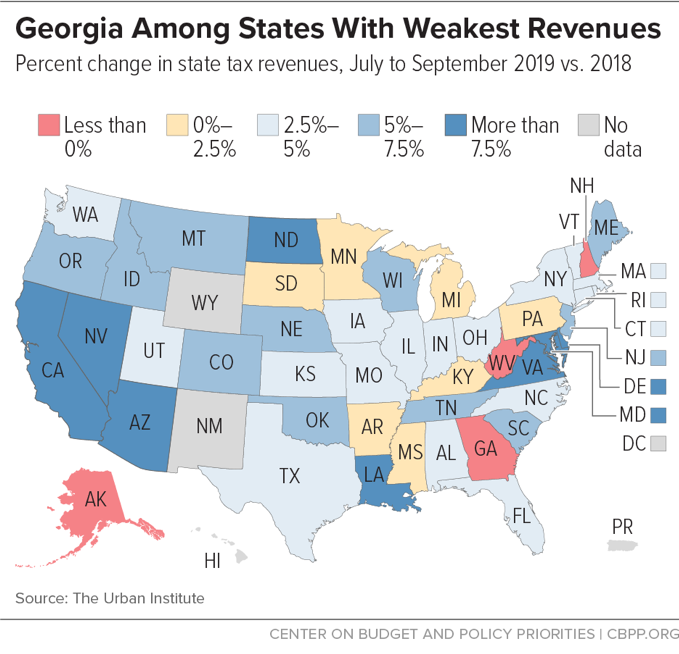BEYOND THE NUMBERS
Georgia started its legislative session facing possible cuts in key services due to a budget crisis, but lawmakers are nevertheless considering a pair of risky tax plans that would make the crisis even worse. The legislature should reject both tax packages to avoid any further harm to essential services and the families they serve.
Most states began 2020 able to adequately fund basic functions such as health and safety inspections and child protective services. Some even had a bit extra in the bank to fund some new initiatives, like expanding pre-K education. Across the nation, states have enjoyed fairly strong revenue collections the past few years, with 43 states reporting year-over-year increases in the first quarter of the 2020 state fiscal year, as the map below shows.
But the Peach State’s budget is in crisis due to past policy missteps and other factors. After a stretch of strong growth during the 2010s, Georgia revenues slowed substantially in 2019 after lawmakers hastily cut the state’s top personal income tax rate in 2018. Other factors, such as a modest leveling-off of economic activity and an ambitious teacher pay increase that lawmakers approved in 2019, also contributed.
Now, state lawmakers are wrestling with how to meet basic responsibilities like funding child welfare services and supporting people with disabilities and considering cuts across a range of crucial services. Gov. Brian Kemp’s new budget for 2021 includes deep cuts to mental health and substance use disorder services, public safety, and important rural programs, among others. Outside of core functions like covering the costs of increased K-12 enrollment and state courts, essentially every Georgia agency faces potential cuts — most between about 3 and 6 percent.
Nevertheless, legislators are considering two more tax cuts that would further worsen the state’s revenue situation. The first would reduce both the state’s top personal income and corporate income tax rates from 5.75 percent to 5.5 percent, which would cost Georgia as much as $615 million a year, or more than 2 percent of the state’s general revenue.
Technically, that rate cut would be the second step in a two-stage tax cut that was envisioned in the 2018 plan. But that legislation stipulated that lawmakers would have to vote again this year to reaffirm the second cut. That gives Georgia leaders the chance to arrest the state’s revenue slide by rejecting the new cut.
The stakes are high. Gov. Kemp didn’t build the resulting additional revenue shortfall into his budget. So if lawmakers cut the rate again, they’ll have to close the hole either through more budget cuts — possibly jeopardizing services like K-12 public schools and Medicaid that have been largely spared so far — or by identifying new revenue sources.
A second proposal takes a different, yet still flawed, approach. Its core provision would replace Georgia’s longstanding graduated personal income tax structure with a 5.5 percent flat tax. While initial cost estimates project lost revenue ranging from about $40 million to $191 million in the current budget year, switching to a flat tax could cost more than anticipated in the long run and further weaken Georgia’s fiscal health over time. That’s because higher rates on higher incomes do a better job at capturing revenues from the growing share of economic gains that have continued flowing to the very top in recent years.
Flat tax rate structures also inherently fall much harder on low- and moderate-income people, since they do not tax people’s initial, smaller bands of income at lower rates. Indeed, that’s why an estimated 84 percent of the gain from the proposal would flow to the state’s top 5 percent, or taxpayers with incomes above $240,000 a year, according to the Institute on Taxation and Economic Policy. States should be working to eliminate flat taxes in favor of fairer graduated rates, as Illinois may soon do, rather than adopting them.
Over the longer term, the state’s policymakers would be wise to follow the lead of states like Minnesota and New Mexico, which have in recent years made smart, targeted tax reforms to raise revenues for pro-growth investments in people and communities. States grow more prosperous and equitable — and all their residents benefit — when they commit to paying for stronger schools, world-class infrastructure, quality health care, and better access to pathways to opportunity like college and child care.

